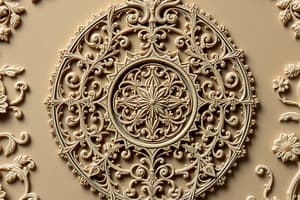Podcast
Questions and Answers
What G code is used for absolute programming?
What G code is used for absolute programming?
- G91
- G02
- G90 (correct)
- G19
Which code initiates a tool change in a CNC program?
Which code initiates a tool change in a CNC program?
- M01
- M02
- M00
- M06 (correct)
In the context of circular motion, what does G02 indicate?
In the context of circular motion, what does G02 indicate?
- Linear motion
- End of program
- Circular motion counterclockwise
- Circular motion clockwise (correct)
Which code would you use to specify the spindle speed in rpm?
Which code would you use to specify the spindle speed in rpm?
What does the M08 code signify in auxiliary functions?
What does the M08 code signify in auxiliary functions?
What is the purpose of the simulation step in the manual programming process?
What is the purpose of the simulation step in the manual programming process?
What aspect should be considered when selecting tools for elementary operations?
What aspect should be considered when selecting tools for elementary operations?
Which step is essential for minimizing machine disruptions during programming?
Which step is essential for minimizing machine disruptions during programming?
In computer-assisted programming (CAM), how are trajectories typically generated?
In computer-assisted programming (CAM), how are trajectories typically generated?
What is one of the primary functions of conversational programming?
What is one of the primary functions of conversational programming?
What is the purpose of the 'End of program' section in a machining program?
What is the purpose of the 'End of program' section in a machining program?
Which G code is used for linear movement in a machining program?
Which G code is used for linear movement in a machining program?
In the context of machining programs, what does the 'F' in programming syntax represent?
In the context of machining programs, what does the 'F' in programming syntax represent?
Which of the following codes cancels tool radius compensation?
Which of the following codes cancels tool radius compensation?
What information does a machining program block need to contain?
What information does a machining program block need to contain?
What does the command G00 in line 20 denote?
What does the command G00 in line 20 denote?
Which G-code command is used for drilling with time control?
Which G-code command is used for drilling with time control?
What is the purpose of the command G02 in line 60?
What is the purpose of the command G02 in line 60?
In line 40, the code G01 is used for what type of movement?
In line 40, the code G01 is used for what type of movement?
What type of operation does G86 correspond to?
What type of operation does G86 correspond to?
How is a parameter typically denoted in parametric programming?
How is a parameter typically denoted in parametric programming?
In line 180, what does the command M09 accomplish?
In line 180, what does the command M09 accomplish?
What is the purpose of the F3 key in the operation of the machine?
What is the purpose of the F3 key in the operation of the machine?
What is the function of G69 in lathe programming?
What is the function of G69 in lathe programming?
Which control system description matches a method that uses fixed points for movement?
Which control system description matches a method that uses fixed points for movement?
Which of the following operational instructions affects all subsequent coordinates in a program?
Which of the following operational instructions affects all subsequent coordinates in a program?
What does clicking F6 enable the operator to do?
What does clicking F6 enable the operator to do?
What is the effect of the 'C' modal instruction in operational programming?
What is the effect of the 'C' modal instruction in operational programming?
Which factor should be ensured before launching the machine using the green button?
Which factor should be ensured before launching the machine using the green button?
What distinguishes the contour control system from the others?
What distinguishes the contour control system from the others?
Which instruction would you use to mirror movements along the X axis?
Which instruction would you use to mirror movements along the X axis?
What is an example of a parameter definition block?
What is an example of a parameter definition block?
What does the command 'Z=R5' in the example 'N38 Z=R5 X=-R29' indicate?
What does the command 'Z=R5' in the example 'N38 Z=R5 X=-R29' indicate?
Which function is associated with the F5 key on the main screen?
Which function is associated with the F5 key on the main screen?
What does the F3 key do on the F8 Services screen?
What does the F3 key do on the F8 Services screen?
In the RouterLink GUI, which key combination is used to deactivate zoom in the Program Editor screen?
In the RouterLink GUI, which key combination is used to deactivate zoom in the Program Editor screen?
Which option corresponds to the tool types for fixed tools in RouterLink?
Which option corresponds to the tool types for fixed tools in RouterLink?
How is the command 'X=-R29/2' likely interpreted in the context of operations with parameters?
How is the command 'X=-R29/2' likely interpreted in the context of operations with parameters?
What is the function of the F6 key on the F8 Services screen?
What is the function of the F6 key on the F8 Services screen?
Flashcards
Machining Program
Machining Program
A set of instructions that define the path of the cutting tool, speeds, and other parameters for a machining operation.
Block Number (N)
Block Number (N)
A unique identifier for each instruction in a machining program.
Preparatory Functions (G Codes)
Preparatory Functions (G Codes)
Instructions that determine the type of motion, cutting mode, or other machining parameters.
Spindle Speed (S)
Spindle Speed (S)
Signup and view all the flashcards
Tool Radius Compensation (G41/G42)
Tool Radius Compensation (G41/G42)
Signup and view all the flashcards
CAM
CAM
Signup and view all the flashcards
Conversational Programming
Conversational Programming
Signup and view all the flashcards
Analyze Part Drawing
Analyze Part Drawing
Signup and view all the flashcards
Tool Selection
Tool Selection
Signup and view all the flashcards
Define Machining Conditions
Define Machining Conditions
Signup and view all the flashcards
G02, G03
G02, G03
Signup and view all the flashcards
M Codes
M Codes
Signup and view all the flashcards
F (Feed Rate)
F (Feed Rate)
Signup and view all the flashcards
F2 Key
F2 Key
Signup and view all the flashcards
F6 Key
F6 Key
Signup and view all the flashcards
Point-to-Point Control
Point-to-Point Control
Signup and view all the flashcards
Paraxial Control
Paraxial Control
Signup and view all the flashcards
Contour Control
Contour Control
Signup and view all the flashcards
Program Header
Program Header
Signup and view all the flashcards
Operational Instructions
Operational Instructions
Signup and view all the flashcards
Modal Instructions
Modal Instructions
Signup and view all the flashcards
Parameter Definition Block
Parameter Definition Block
Signup and view all the flashcards
Using Previously Defined Parameters
Using Previously Defined Parameters
Signup and view all the flashcards
Operations with Parameters
Operations with Parameters
Signup and view all the flashcards
F8 Services Screen
F8 Services Screen
Signup and view all the flashcards
Fixed Tools (Drills)
Fixed Tools (Drills)
Signup and view all the flashcards
Other Groups of Tools (Cutters)
Other Groups of Tools (Cutters)
Signup and view all the flashcards
Study Notes
Control Numerical (CN) Definition
- CN is a programmable automation method
- Instructions (programs) control machine actions and movements
- Suitable for low to medium production volumes
- Easier to write new programs than modify existing equipment
Basic Elements of a CN System
- Program: Set of instructions to guide the processing equipment, written in a specific language (code).
- Control unit (CN): Interprets instructions from the program, converting them into signals that operate the machine devices.
- Processing equipment: Performs the actual work; includes worktables, machine tools, and motors/controls for their movement.
Classification of Numerical Controls
- Reference System: Fixed or floating
- Trajectory Control: Point-to-point or continuous
- Actuation Type: Hydraulic, electric, or pneumatic
- Control Loop: Open or closed
- Control Technique: Numerical Control (CN) Hardware, Computerized Numerical Control (CNC) Software, and Adaptive Numerical Control (CNA)
Characteristics of a CN Machine Tool
- Positioning mechanisms: Actuators (motors, valves, etc.) and control systems (open or closed loop)
- Measurement systems: Sensors (induction, photoelectric, etc.)
- Machine design: Precision and repeatability, chip removal systems
- Tool changing mechanisms: Turrets, tool magazines
- Control techniques: CN, CNC, and CNA
When is CN Applicable?
- Low to mid-volume production
- Complex part geometry
- Frequent design changes
- High precision and reliability requirements
- High production costs for part failures
- 100% inspection requirement
Types of Programming
- Manual Programming: Calculating trajectories manually, entering code on a console or PC
- Computer-Aided Programming (Pseudo-aided): CAD drawings to define points and manual operation using a console or PC
- Computer-Assisted Programming (CAM): CAD drawings generate trajectories, automatic calculation, collision detection, process simulation
Manual Programming Steps
- Analyze the part drawing (dimensions, tolerances, finishes, materials)
- Define elementary operations and their order
- Calculate each operation's trajectories and path
- Select appropriate machines and operation sequence
- Choose appropriate tool for each operation
Programming Results (Steps 1-5)
- Analyzing part drawing
- Defining elementary operations
- Calculating trajectories
- Selecting machines and operations
- Selecting tools
Programming Definition (Step 6)
- Following an ISO standard
- Coding the program
Programming Tests and Execution (Steps 7-8)
- Testing: Simulation in software, testing on soft material, verifying Z-axis corrections
- Execution: Block-by-block execution, overseeing each operation before proceeding, automatic execution (normal operation).
Stages in CNC Processing
- Preparation Stages: Planning the work and setting the data for the program
- Programming Stage: Creating and testing the programs for the machine to execute
- Adjustment Stage: Adjusting the machine to the program
- Ordering Launch Stage: Sending the program to be processed on the machine
Axes and Coordinate Systems
- Z-axis: Principal spindle axis. Indicating positive direction away from the part or in a consistent direction depending on the machinery.
- X-axis: Generally horizontal axis, dependent on the orientation of the Z-axis.
- Y-axis: Generally horizontal axis, perpendicular to the X and Z axes forming a right-handed coordinate system.
- Auxiliary Axes: Other axes (U, V, W) that are parallel to the principal axes or axes of rotational movement (A, B, C).
Points of Reference
- Machine Zero (M): Coordinate origin relative to the machine. Standardized according to machine axes.
- Machine Reference Point (R): Reference point for tool changes.
- Part Zero (W): Reference point on the part. Freely chosen by the programmer.
- Tool Adjustment Point (E): Specific point on the cutting tool used to calculate movements and compensate for tool wear.
ISO Programming Language
- Header (Program identifier, part information, process details).
- Program Body (Program steps, numerical instructions, and parameters, comments and function calls, etc.)
- End of Program Section.
Numerical Control Parameter Programming
- Programming Parameters: Quantities defining the machine tool settings.
- Variable parameters
- Numerical Constants
CNC Coordinate Systems
- Absolute positioning
- Incremental positioning
Control Numerical System
- Point-to-Point System
- Paraxial System
- Contouring System
CNC Programming
- Formatting
- Data Entry
- Verification
- Execution
Studying That Suits You
Use AI to generate personalized quizzes and flashcards to suit your learning preferences.



